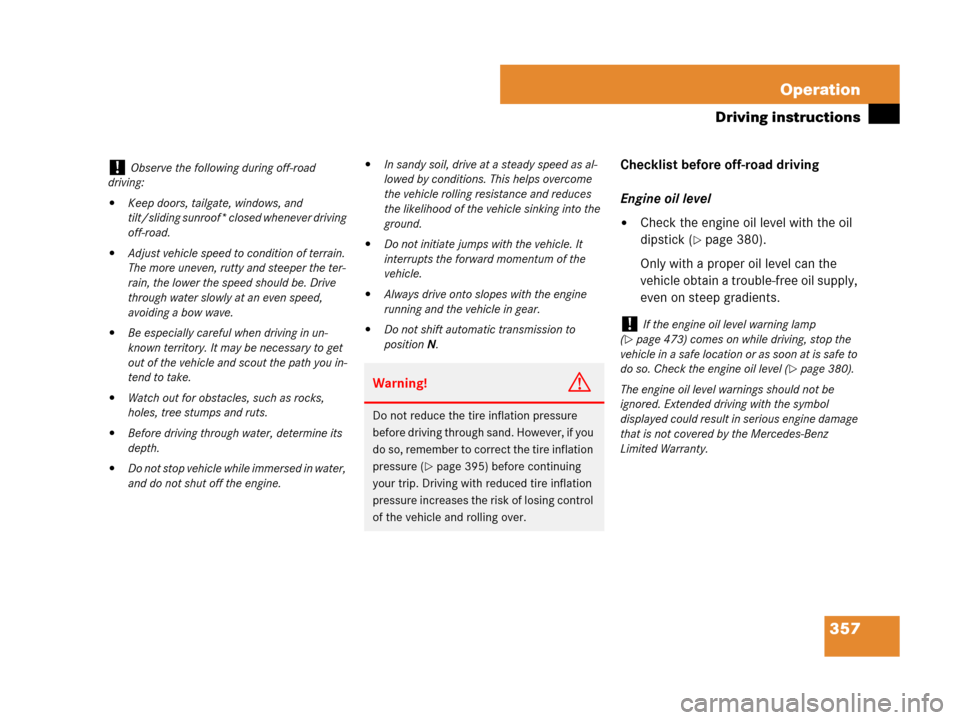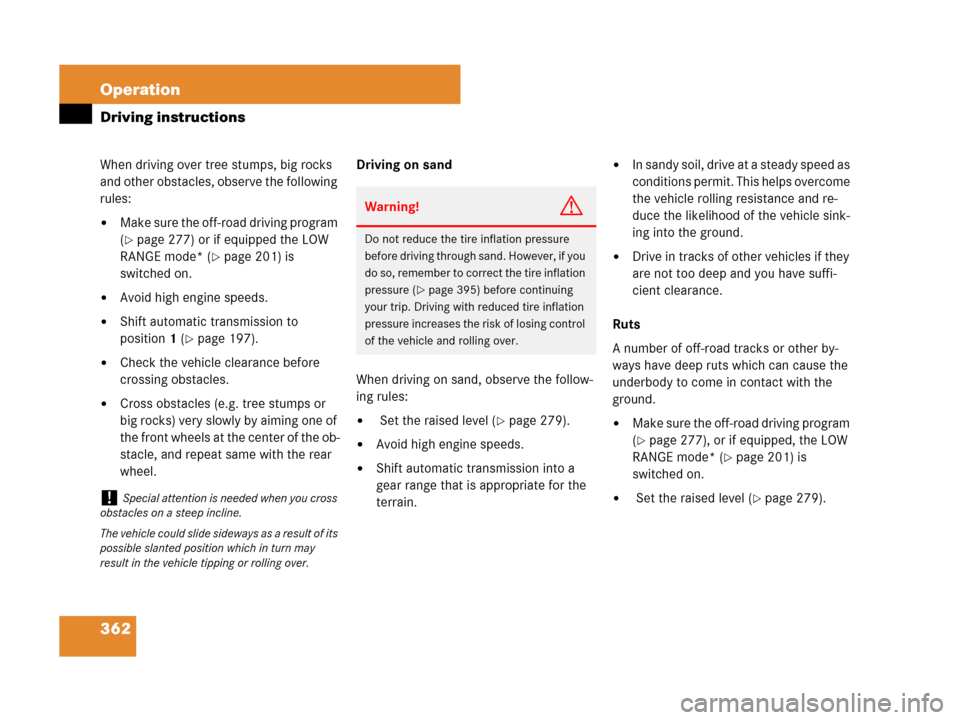Page 358 of 601

357 Operation
Driving instructions
Checklist before off-road driving
Engine oil level
�Check the engine oil level with the oil
dipstick (
�page 380).
Only with a proper oil level can the
vehicle obtain a trouble-free oil supply,
even on steep gradients.
!Observe the following during off-road
driving:
�Keep doors, tailgate, windows, and
tilt/sliding sunroof* closed whenever driving
off-road.
�Adjust vehicle speed to condition of terrain.
The more uneven, rutty and steeper the ter-
rain, the lower the speed should be. Drive
through water slowly at an even speed,
avoiding a bow wave.
�Be especially careful when driving in un-
known territory. It may be necessary to get
out of the vehicle and scout the path you in-
tend to take.
�Watch out for obstacles, such as rocks,
holes, tree stumps and ruts.
�Before driving through water, determine its
depth.
�Do not stop vehicle while immersed in water,
and do not shut off the engine.
�In sandy soil, drive at a steady speed as al-
lowed by conditions. This helps overcome
the vehicle rolling resistance and reduces
the likelihood of the vehicle sinking into the
ground.
�Do not initiate jumps with the vehicle. It
interrupts the forward momentum of the
vehicle.
�Always drive onto slopes with the engine
running and the vehicle in gear.
�Do not shift automatic transmission to
positionN.
Warning!G
Do not reduce the tire inflation pressure
before driving through sand. However, if you
do so, remember to correct the tire inflation
pressure (
�page 395) before continuing
your trip. Driving with reduced tire inflation
pressure increases the risk of losing control
of the vehicle and rolling over.
!If the engine oil level warning lamp
(
�page 473) comes on while driving, stop the
vehicle in a safe location or as soon at is safe to
do so. Check the engine oil level (
�page 380).
The engine oil level warnings should not be
ignored. Extended driving with the symbol
displayed could result in serious engine damage
that is not covered by the Mercedes-Benz
Limited Warranty.
164.boo Seite 357 Freitag, 30. März 2007 12:54 12
Page 363 of 601

362 Operation
Driving instructions
When driving over tree stumps, big rocks
and other obstacles, observe the following
rules:
�Make sure the off-road driving program
(
�page 277) or if equipped the LOW
RANGE mode* (
�page 201) is
switched on.
�Avoid high engine speeds.
�Shift automatic transmission to
position1 (
�page 197).
�Check the vehicle clearance before
crossing obstacles.
�Cross obstacles (e.g. tree stumps or
big rocks) very slowly by aiming one of
the front wheels at the center of the ob-
stacle, and repeat same with the rear
wheel.Driving on sand
When driving on sand, observe the follow-
ing rules:
� Set the raised level (�page 279).
�Avoid high engine speeds.
�Shift automatic transmission into a
gear range that is appropriate for the
terrain.
�In sandy soil, drive at a steady speed as
conditions permit. This helps overcome
the vehicle rolling resistance and re-
duce the likelihood of the vehicle sink-
ing into the ground.
�Drive in tracks of other vehicles if they
are not too deep and you have suffi-
cient clearance.
Ruts
A number of off-road tracks or other by-
ways have deep ruts which can cause the
underbody to come in contact with the
ground.
�Make sure the off-road driving program
(
�page 277), or if equipped, the LOW
RANGE mode* (
�page 201) is
switched on.
� Set the raised level (�page 279).!Special attention is needed when you cross
obstacles on a steep incline.
The vehicle could slide sideways as a result of its
possible slanted position which in turn may
result in the vehicle tipping or rolling over.
Warning!G
Do not reduce the tire inflation pressure
before driving through sand. However, if you
do so, remember to correct the tire inflation
pressure (
�page 395) before continuing
your trip. Driving with reduced tire inflation
pressure increases the risk of losing control
of the vehicle and rolling over.
164.boo Seite 362 Freitag, 30. März 2007 12:54 12
Page 567 of 601

566 Technical data
Fuels, coolants, lubricants
These blends must also meet all other fuel
requirements, such as resistance to spark
knock, boiling range, vapor pressure, etc.
Diesel engine
Only use commercially available vehicular
ULTRA-LOW SULFUR HIGHWAY DIESEL
FUEL (15 ppm SULFUR MAXIMUM).
To prevent malfunctions, diesel fuel with
improved cold flow characteristics is of-
fered in the winter months. Check with
your fuel retailer.Gasoline additives (gasoline engine)
A major concern among engine
manufacturers is carbon build-up caused
by gasoline. Mercedes-Benz recommends
only the use of quality gasoline containing
additives that prevent the build-up of
carbon deposits.
After an extended period of using fuels
without such additives carbon deposits
can build up, especially on the intake
valves and in the combustion area, leading
to engine performance problems such as:
�Warm-up hesitation
�Unstable idle
�Knocking/pinging
�Misfire
�Power lossIn areas where carbon deposits may be
encountered due to lack of availability of
gasolines which contain these additives,
Mercedes-Benz recommends the use of
additives approved by us for use on
Mercedes-Benz vehicles. Refer to the
Factory Approved Service Products
pamphlet (USA only) or contact an
authorized Mercedes-Benz Light Truck
Center for a listing of approved product(s).
Follow directions on product label.
Do not blend other fuel additives with fuel.
This only results in unnecessary costs and
may be harmful to the engine operation.
!Do not fill the tank with gasoline. Do not
blend diesel fuel with gasoline or kerosine. The
fuel system and engine will otherwise be
damaged, which is not covered by the
Mercedes-Benz Limited Warranty.
!Damage or malfunction resulting from poor
fuel quality or from blending additional fuel
additives other than those tested and approved
by us for use on Mercedes-Benz vehicles are not
covered by the Mercedes-Benz Limited
Warranty.
164.boo Seite 566 Freitag, 30. März 2007 12:54 12